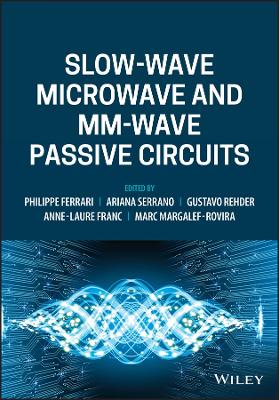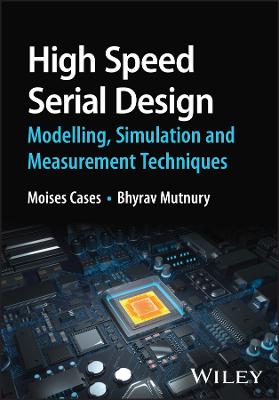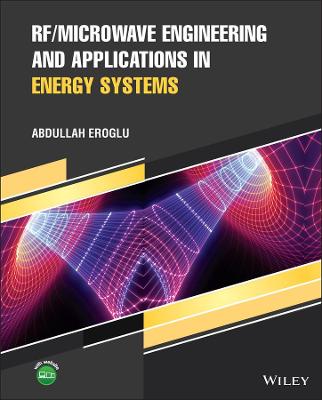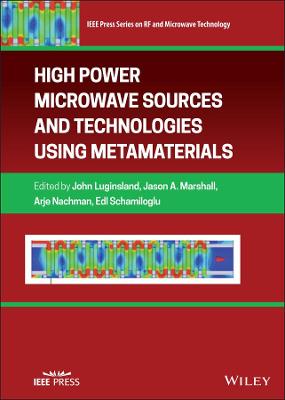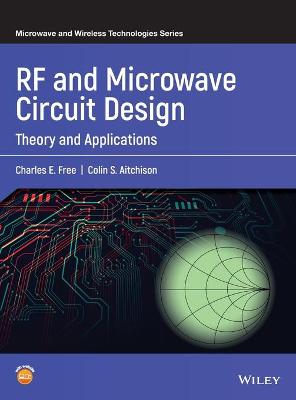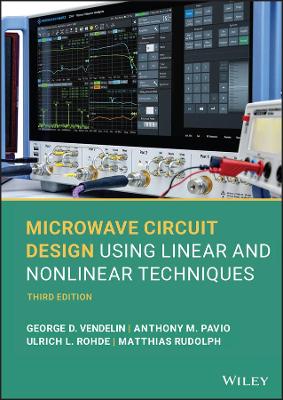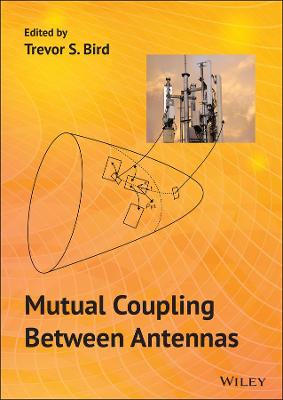High Frequency Techniques
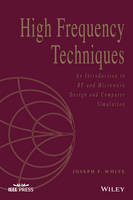 -15%
portes grátis
-15%
portes grátis
High Frequency Techniques
An Introduction to RF and Microwave Design and Computer Simulation
White, Joseph F.
John Wiley & Sons Inc
09/2016
528
Mole
Inglês
9781119244509
15 a 20 dias
772
1 Introduction 1
1.1 Beginning of Wireless 1
1.2 Current Radio Spectrum 4
1.3 Conventions Used in This Text 8
Sections 8
Equations 8
Figures 8
Exercises 8
Symbols 8
Prefixes 10
Fonts 10
1.4 Vectors and Coordinates 11
1.5 General Constants and Useful Conversions 14
2 Review of AC Analysis and Network Simulation 16
2.1 Basic Circuit Elements 16
The Resistor 16
Ohm's Law 18
The Inductor 19
The Capacitor 20
2.2 Kirchhoff's Laws 22
2.3 Alternating Current (AC) Analysis 23
Ohm's Law in Complex Form 26
2.4 Voltage and Current Phasors 26
2.5 Impedance 28
Estimating Reactance 28
Addition of Series Impedances 29
2.6 Admittance 30
Admittance Definition 30
Addition of Parallel Admittances 30
The Product over the Sum 32
2.7 LLFPB Networks 33
2.8 Decibels, dBW, and dBm 33
Logarithms (Logs) 33
Multiplying by Adding Logs 34
Dividing by Subtracting Logs 34
Zero Powers 34
Bel Scale 34
Decibel Scale 35
Decibels-Relative Measures 35
Absolute Power Levels-dBm and dBW 37
Decibel Power Scales 38
2.9 Power Transfer 38
Calculating Power Transfer 38
Maximum Power Transfer 39
2.10 Specifying Loss 40
Insertion Loss 40
Transducer Loss 41
Loss Due to a Series Impedance 42
Loss Due to a Shunt Admittance 43
Loss in Terms of Scattering Parameters 44
2.11 Real RLC Models 44
Resistor with Parasitics 44
Inductor with Parasitics 44
Capacitor with Parasitics 44
2.12 Designing LC Elements 46
Lumped Coils 46
High ? Inductor Cores-the Hysteresis Curve 47
Estimating Wire Inductance 48
Parallel Plate Capacitors 49
2.13 Skin Effect 51
2.14 Network Simulation 53
3 LC Resonance and Matching Networks 59
3.1 LC Resonance 59
3.2 Series Circuit Quality Factors 60
Q of Inductors and Capacitors 60
QE, External Q 61
QL, Loaded Q 62
3.3 Parallel Circuit Quality Factors 62
3.4 Coupled Resonators 63
Direct Coupled Resonators 63
Lightly Coupled Resonators 63
3.5 Q Matching 67
Low to High Resistance 67
Broadbanding the Q Matching Method 70
High to Low Resistance 71
4 Distributed Circuits 78
4.1 Transmission Lines 78
4.2 Wavelength in a Dielectric 81
4.3 Pulses on Transmission Lines 82
4.4 Incident and Reflected Waves 83
4.5 Reflection Coefficient 85
4.6 Return Loss 86
4.7 Mismatch Loss 86
4.8 Mismatch Error 87
4.9 The Telegrapher Equations 91
4.10 Transmission Line Wave Equations 92
4.11 Wave Propagation 94
4.12 Phase and Group Velocities 97
4.13 Reflection Coefficient and Impedance 100
4.14 Impedance Transformation Equation 101
4.15 Impedance Matching with One Transmission Line 108
4.16 Fano's (and Bode's) Limit 109
Type A Mismatched Loads 109
Type B Mismatched Loads 112
Impedance Transformation Not Included 113
5 The Smith Chart 119
5.1 Basis of the Smith Chart 119
5.2 Drawing the Smith Chart 124
5.3 Admittance on the Smith Chart 130
5.4 Tuning a Mismatched Load 132
5.5 Slotted-Line Impedance Measurement 135
5.6 VSWR = r 139
5.7 Negative Resistance Smith Chart 140
5.8 Navigating the Smith Chart 140
5.9 Smith Chart Software 145
5.10 Estimating Bandwidth on the Smith Chart 147
5.11 Approximate Tuning May Be Better 148
5.12 Frequency Contours on the Smith Chart 150
5.13 Using the Smith Chart without Transmission Lines 150
5.14 Constant Q Circles 151
5.15 Transmission Line Lumped Circuit Equivalent 153
6 Matrix Analysis 161
6.1 Matrix Algebra 161
6.2 Z and Y Matrices 164
6.3 Reciprocity 166
6.4 The ABCD Matrix 167
6.5 The Scattering Matrix 172
6.6 The Transmission Matrix 177
7 Electromagnetic Fields and Waves 183
7.1 Vector Force Fields 183
7.2 E and H Fields 185
7.3 Electric Field E 185
7.4 Magnetic Flux Density 187
7.5 Vector Cross Product 188
7.6 Electrostatics and Gauss's Law 193
7.7 Vector Dot Product and Divergence 194
7.8 Static Potential Function and the Gradient 196
7.9 Divergence of the B Field 200
7.10 Ampere's Law 201
7.11 Vector Curl 202
7.12 Faraday's Law of Induction 208
7.13 Maxwell's Equations 209
Maxwell's Four Equations 209
Auxiliary Relations and Definitions 210
Visualizing Maxwell's Equations 211
7.14 Primary Vector Operations 214
7.15 The Laplacian 215
7.16 Vector and Scalar Identities 218
7.17 Free Charge within a Conductor 219
7.18 Skin Effect 221
7.19 Conductor Internal Impedance 224
7.20 The Wave Equation 227
7.21 The Helmholtz Equations 229
7.22 Plane Propagating Waves 230
7.23 Poynting's Theorem 233
7.24 Wave Polarization 236
7.25 EH Fields on Transmission Lines 240
7.26 Waveguides 246
General Waveguide Solution 246
Waveguide Types 250
Rectangular Waveguide Fields 251
Applying Boundary Conditions 252
Propagation Constants and Waveguide Modes 253
Characteristic Wave Impedance for Waveguides 256
Phase and Group Velocities 257
TE and TM Mode Summary for Rectangular Waveguide 257
7.27 Fourier Series and Green's Functions 261
Fourier Series 261
Green's Functions 263
7.28 Higher Order Modes in Circuits 269
7.29 Vector Potential 271
7.30 Retarded Potentials 274
7.31 Potential Functions in the Sinusoidal Case 275
7.32 Antennas 275
Short Straight Wire Antenna 275
Radiation Resistance 279
Radiation Pattern 280
Half-Wavelength Dipole 280
Antenna Gain 283
Antenna Effective Area 284
Monopole Antenna 285
Aperture Antennas 286
Phased Arrays 288
7.33 Path Loss 290
7.34 Electromagnetic (EM) Simulation 294
8 Directional Couplers 307
8.1 Wavelength Comparable Dimensions 307
8.2 The Backward Wave Coupler 307
8.3 Even- and Odd-Mode Analysis 309
8.4 Reflectively Terminated 3-dB Coupler 320
8.5 Coupler Specifications 323
8.6 Measurements Using Directional Couplers 325
8.7 Network Analyzer Impedance Measurements 326
8.8 Two-Port Scattering Measurements 327
8.9 Branch Line Coupler 327
8.10 Hybrid Ring Coupler 330
8.11 Wilkinson Power Divider 330
9 Filter Design 335
9.1 Voltage Transfer Function 335
9.2 Low-Pass Prototype 336
9.3 Butterworth or Maximally Flat Filter 337
9.4 Denormalizing the Prototype Response 339
9.5 High-Pass Filters 343
9.6 Bandpass Filters 345
9.7 Bandstop Filters 349
9.8 Chebyshev Filters 351
9.9 Phase and Group Delay 356
9.10 Filter Q 361
9.11 Diplexer Filters 364
9.12 Top-Coupled Bandpass Filters 367
9.13 Elliptic Filters 369
9.14 Distributed Filters 370
9.15 The Richards Transformation 374
9.16 Kuroda's Identities 379
9.17 Mumford's Maximally Flat Stub Filters 381
9.18 Filter Design with the Optimizer 384
9.19 Statistical Design and Yield Analysis 386
Using Standard Part Values 386
The Normal Distribution 387
Other Distributions 391
10 Transistor Amplifier Design 399
10.1 Unilateral Design 399
Evaluating S Parameters 399
Transistor Biasing 400
Evaluating RF Performance 403
10.2 Amplifier Stability 405
10.3 K Factor 409
10.4 Transducer Gain 413
10.5 Unilateral Gain Design 416
10.6 Unilateral Gain Circles 422
Input Gain Circles 422
Output Gain Circles 424
10.7 Simultaneous Conjugate Match Design 428
10.8 Various Gain Definitions 431
10.9 Operating Gain Design 433
10.10 Available Gain Design 437
10.11 Noise in Systems 442
Thermal Noise Limit 442
Other Noise Sources 444
Noise Figure of a Two-Port Network 445
Noise Factor of a Cascade 447
Noise Temperature 448
10.12 Low-Noise Amplifiers 450
10.13 Amplifier Nonlinearity 455
Gain Saturation 455
Intermodulation Distortion 456
10.14 Broadbanding with Feedback 460
10.15 Cascading Amplifier Stages 466
10.16 Amplifier Design Summary 468
Appendices
A. Symbols and Units 474
B. Complex Mathematics 478
C. Diameter and Resistance of Annealed Copper Wire by Gauge Size 483
D. Properties of Some Materials 485
E. Standard Rectangular Waveguides 486
Frequently Used Relations 487
Index 491
1 Introduction 1
1.1 Beginning of Wireless 1
1.2 Current Radio Spectrum 4
1.3 Conventions Used in This Text 8
Sections 8
Equations 8
Figures 8
Exercises 8
Symbols 8
Prefixes 10
Fonts 10
1.4 Vectors and Coordinates 11
1.5 General Constants and Useful Conversions 14
2 Review of AC Analysis and Network Simulation 16
2.1 Basic Circuit Elements 16
The Resistor 16
Ohm's Law 18
The Inductor 19
The Capacitor 20
2.2 Kirchhoff's Laws 22
2.3 Alternating Current (AC) Analysis 23
Ohm's Law in Complex Form 26
2.4 Voltage and Current Phasors 26
2.5 Impedance 28
Estimating Reactance 28
Addition of Series Impedances 29
2.6 Admittance 30
Admittance Definition 30
Addition of Parallel Admittances 30
The Product over the Sum 32
2.7 LLFPB Networks 33
2.8 Decibels, dBW, and dBm 33
Logarithms (Logs) 33
Multiplying by Adding Logs 34
Dividing by Subtracting Logs 34
Zero Powers 34
Bel Scale 34
Decibel Scale 35
Decibels-Relative Measures 35
Absolute Power Levels-dBm and dBW 37
Decibel Power Scales 38
2.9 Power Transfer 38
Calculating Power Transfer 38
Maximum Power Transfer 39
2.10 Specifying Loss 40
Insertion Loss 40
Transducer Loss 41
Loss Due to a Series Impedance 42
Loss Due to a Shunt Admittance 43
Loss in Terms of Scattering Parameters 44
2.11 Real RLC Models 44
Resistor with Parasitics 44
Inductor with Parasitics 44
Capacitor with Parasitics 44
2.12 Designing LC Elements 46
Lumped Coils 46
High ? Inductor Cores-the Hysteresis Curve 47
Estimating Wire Inductance 48
Parallel Plate Capacitors 49
2.13 Skin Effect 51
2.14 Network Simulation 53
3 LC Resonance and Matching Networks 59
3.1 LC Resonance 59
3.2 Series Circuit Quality Factors 60
Q of Inductors and Capacitors 60
QE, External Q 61
QL, Loaded Q 62
3.3 Parallel Circuit Quality Factors 62
3.4 Coupled Resonators 63
Direct Coupled Resonators 63
Lightly Coupled Resonators 63
3.5 Q Matching 67
Low to High Resistance 67
Broadbanding the Q Matching Method 70
High to Low Resistance 71
4 Distributed Circuits 78
4.1 Transmission Lines 78
4.2 Wavelength in a Dielectric 81
4.3 Pulses on Transmission Lines 82
4.4 Incident and Reflected Waves 83
4.5 Reflection Coefficient 85
4.6 Return Loss 86
4.7 Mismatch Loss 86
4.8 Mismatch Error 87
4.9 The Telegrapher Equations 91
4.10 Transmission Line Wave Equations 92
4.11 Wave Propagation 94
4.12 Phase and Group Velocities 97
4.13 Reflection Coefficient and Impedance 100
4.14 Impedance Transformation Equation 101
4.15 Impedance Matching with One Transmission Line 108
4.16 Fano's (and Bode's) Limit 109
Type A Mismatched Loads 109
Type B Mismatched Loads 112
Impedance Transformation Not Included 113
5 The Smith Chart 119
5.1 Basis of the Smith Chart 119
5.2 Drawing the Smith Chart 124
5.3 Admittance on the Smith Chart 130
5.4 Tuning a Mismatched Load 132
5.5 Slotted-Line Impedance Measurement 135
5.6 VSWR = r 139
5.7 Negative Resistance Smith Chart 140
5.8 Navigating the Smith Chart 140
5.9 Smith Chart Software 145
5.10 Estimating Bandwidth on the Smith Chart 147
5.11 Approximate Tuning May Be Better 148
5.12 Frequency Contours on the Smith Chart 150
5.13 Using the Smith Chart without Transmission Lines 150
5.14 Constant Q Circles 151
5.15 Transmission Line Lumped Circuit Equivalent 153
6 Matrix Analysis 161
6.1 Matrix Algebra 161
6.2 Z and Y Matrices 164
6.3 Reciprocity 166
6.4 The ABCD Matrix 167
6.5 The Scattering Matrix 172
6.6 The Transmission Matrix 177
7 Electromagnetic Fields and Waves 183
7.1 Vector Force Fields 183
7.2 E and H Fields 185
7.3 Electric Field E 185
7.4 Magnetic Flux Density 187
7.5 Vector Cross Product 188
7.6 Electrostatics and Gauss's Law 193
7.7 Vector Dot Product and Divergence 194
7.8 Static Potential Function and the Gradient 196
7.9 Divergence of the B Field 200
7.10 Ampere's Law 201
7.11 Vector Curl 202
7.12 Faraday's Law of Induction 208
7.13 Maxwell's Equations 209
Maxwell's Four Equations 209
Auxiliary Relations and Definitions 210
Visualizing Maxwell's Equations 211
7.14 Primary Vector Operations 214
7.15 The Laplacian 215
7.16 Vector and Scalar Identities 218
7.17 Free Charge within a Conductor 219
7.18 Skin Effect 221
7.19 Conductor Internal Impedance 224
7.20 The Wave Equation 227
7.21 The Helmholtz Equations 229
7.22 Plane Propagating Waves 230
7.23 Poynting's Theorem 233
7.24 Wave Polarization 236
7.25 EH Fields on Transmission Lines 240
7.26 Waveguides 246
General Waveguide Solution 246
Waveguide Types 250
Rectangular Waveguide Fields 251
Applying Boundary Conditions 252
Propagation Constants and Waveguide Modes 253
Characteristic Wave Impedance for Waveguides 256
Phase and Group Velocities 257
TE and TM Mode Summary for Rectangular Waveguide 257
7.27 Fourier Series and Green's Functions 261
Fourier Series 261
Green's Functions 263
7.28 Higher Order Modes in Circuits 269
7.29 Vector Potential 271
7.30 Retarded Potentials 274
7.31 Potential Functions in the Sinusoidal Case 275
7.32 Antennas 275
Short Straight Wire Antenna 275
Radiation Resistance 279
Radiation Pattern 280
Half-Wavelength Dipole 280
Antenna Gain 283
Antenna Effective Area 284
Monopole Antenna 285
Aperture Antennas 286
Phased Arrays 288
7.33 Path Loss 290
7.34 Electromagnetic (EM) Simulation 294
8 Directional Couplers 307
8.1 Wavelength Comparable Dimensions 307
8.2 The Backward Wave Coupler 307
8.3 Even- and Odd-Mode Analysis 309
8.4 Reflectively Terminated 3-dB Coupler 320
8.5 Coupler Specifications 323
8.6 Measurements Using Directional Couplers 325
8.7 Network Analyzer Impedance Measurements 326
8.8 Two-Port Scattering Measurements 327
8.9 Branch Line Coupler 327
8.10 Hybrid Ring Coupler 330
8.11 Wilkinson Power Divider 330
9 Filter Design 335
9.1 Voltage Transfer Function 335
9.2 Low-Pass Prototype 336
9.3 Butterworth or Maximally Flat Filter 337
9.4 Denormalizing the Prototype Response 339
9.5 High-Pass Filters 343
9.6 Bandpass Filters 345
9.7 Bandstop Filters 349
9.8 Chebyshev Filters 351
9.9 Phase and Group Delay 356
9.10 Filter Q 361
9.11 Diplexer Filters 364
9.12 Top-Coupled Bandpass Filters 367
9.13 Elliptic Filters 369
9.14 Distributed Filters 370
9.15 The Richards Transformation 374
9.16 Kuroda's Identities 379
9.17 Mumford's Maximally Flat Stub Filters 381
9.18 Filter Design with the Optimizer 384
9.19 Statistical Design and Yield Analysis 386
Using Standard Part Values 386
The Normal Distribution 387
Other Distributions 391
10 Transistor Amplifier Design 399
10.1 Unilateral Design 399
Evaluating S Parameters 399
Transistor Biasing 400
Evaluating RF Performance 403
10.2 Amplifier Stability 405
10.3 K Factor 409
10.4 Transducer Gain 413
10.5 Unilateral Gain Design 416
10.6 Unilateral Gain Circles 422
Input Gain Circles 422
Output Gain Circles 424
10.7 Simultaneous Conjugate Match Design 428
10.8 Various Gain Definitions 431
10.9 Operating Gain Design 433
10.10 Available Gain Design 437
10.11 Noise in Systems 442
Thermal Noise Limit 442
Other Noise Sources 444
Noise Figure of a Two-Port Network 445
Noise Factor of a Cascade 447
Noise Temperature 448
10.12 Low-Noise Amplifiers 450
10.13 Amplifier Nonlinearity 455
Gain Saturation 455
Intermodulation Distortion 456
10.14 Broadbanding with Feedback 460
10.15 Cascading Amplifier Stages 466
10.16 Amplifier Design Summary 468
Appendices
A. Symbols and Units 474
B. Complex Mathematics 478
C. Diameter and Resistance of Annealed Copper Wire by Gauge Size 483
D. Properties of Some Materials 485
E. Standard Rectangular Waveguides 486
Frequently Used Relations 487
Index 491



